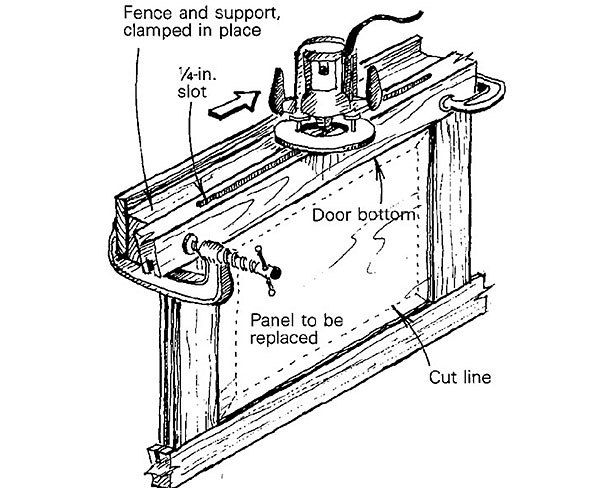
My frame-and-panel garage door had a nasty gouge in one of the bottom panels. My job was to figure out a way to remove the 1/4-in. thick panel without ruining the rest of the door. To do so, I turned to my router.
After removing the door and placing the damaged panel upside-down, I clamped a 2x support adjacent to the bottom frame, as shown in the drawing. Next I used a plunge router fitted with a 1/4-in. straight-flute bit to make a slot in the door bottom. I had to make the slot about 1 in. deep to get to the panel, and I made my passes in 1/4-in. deep increments to avoid overloading the router or straining the bit. Slot cut, I ran my jigsaw around the perimeter of the damaged panel, cutting it into easily removable pieces. To finish the job, I slid the new panel in place through the slot in the bottom of the door. Then I filled the slot with a glued-in-place piece of 1/4-in. stock.
—Elliot Eisenberg, Conyngham, PA
Edited and illustrated by Charles Miller
From Fine Homebuilding #53






























View Comments
When we've had to do this, I use a Fein reciprocating tool with the (mostly) circular blade. That lets us remove and replace the panel without having to remove the door. Working from the inside of the door, I saw through the fixed stops where they meet the stiles and rails. The fine kerf of the blade also means that the formerly fixed stops can be re-used.
May I recommend using a rare earth magnet to check for fasteners and other wayward steel "things" before using a router on old painted wood.
Elliot's method assumes that the bad panel is not glued into the surrounding stiles and rails.
Question: Is that always the case in a garage door?
Gough,
How do you ensure a straight line for your Fein tool cut?
I assume your blade is perpendicular to the door, right?
Currently, I want to replace upper panels in a barn-door style garage door with translucent material, so this info will be helpful.
Thanks